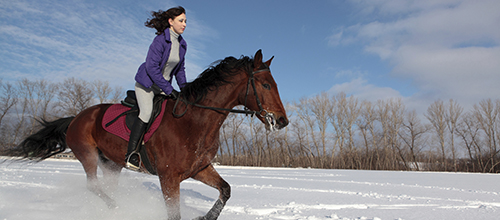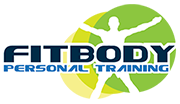
How Riders Can Keep Fit During the Winter Months
All around the country, temperatures hover below freezing, outdoor arenas are shrouded in snow and equine enthusiasts are spending more time chipping ice out of water buckets than in the saddle. For those unfortunate souls in climates with true “winters” and no access to indoor arenas, the season can mean no riding – and in some cases, no exercise at all. How can riders keep reasonably fit to prepare for the next show season? We asked an expert trainer for some tips.
Carolyn Grashof is an American Council on Exercise certified trainer and owner of FitBody Personal Training in Kimberton, PA. She provides personal training services to several riders of a variety of disciplines and runs a dressage rider boot camp for a dozen more. A beginner rider, Grashof combines her more than a decade of fitness expertise with an understanding of what it takes to be physically adept in the saddle. “To help improve my customers’ riding, I focus on postural improvement, balance, flexibility, overall strength and core training,” she says. “Having taken up riding myself, I’ve got new insights as to how best help riders stay fit.”
With all of her clients, whether they ride or not, Grashof starts with these tips to help foster successful, long-term commitments to maintaining physical fitness:
- Find an exercise program that is fun and constantly changing to help the body improve.
- Focus on breathing throughout the entire exercise session.
- Perform each exercise with maximum effort or concentration depending on the type of exercise.
- Always maintain good posture during the exercise and throughout daily activities.
- Be aware of the muscles being worked.
So what can riders do to stay in shape during the long winter months when sitting by the fire with a hot toddy and a good book is tempting? For those willing to venture outside the home, Grashof suggests finding a cross-training program that emphasizes core strength such as Pilates class or boot camp. “Another avenue is to find a personal trainer who understand the demands of a rider and can develop a balanced program custom to their needs,” she says.
But even riders who want to remain in the comfort of their own homes can stay fit with a few simple exercises.
“Most riders need to improve or at least maintain their core strength,” says Grashof. “Abdominal and back exercises are ideal for this. Some options are the Pilates plank position, side plank position, abdominal crunches and abdominal bracing, which is simply contracting the abdominal muscles, holding it and repeating.”
For upper body strength, Grashof suggests push-ups, which work the chest, back, biceps, triceps and shoulders when done correctly. “For push-ups to be the most effective, they have to be done with the right form: hands slightly wider than shoulder-width apart, the body in a straight line, arms straight when at the top of the push-up and eyes ahead, not down.”
To improve balance, which helps riders feel secure in their seat, Grashof suggests standing on one foot without holding onto or leaning against anything. “Once this is mastered, try moving one leg at a time front and back, then abduct it out and eventually move into leg circles.” For advanced balance work, a balance disc or wobble board can be incorporated.
Stabilizing the hips, core and lower back can be accomplished through the use of an exercise ball or balance disc. “The horse is not a stable object, it is constantly changing with the cues riders give while riding,” she says. “The rider needs to be responding continuously to the reactions of the horse, which means the rider needs to be strong, supple and balanced in the saddle.”
Lastly, Grashof encourages riders to invest their time in cross-training programs versus repeating the same exercises over and over. “When the body is accustomed to a constant set of exercises, it does not respond and improve as a person would want it to. The body adapts to the constant demand and certain areas become stronger and tighter while other areas are getting weaker. Cross-training is really a great way to keep all the muscles in a person’s body strong and in balance.”
For more information about Grashof, visit www.fitbodyforeverybody.com.
